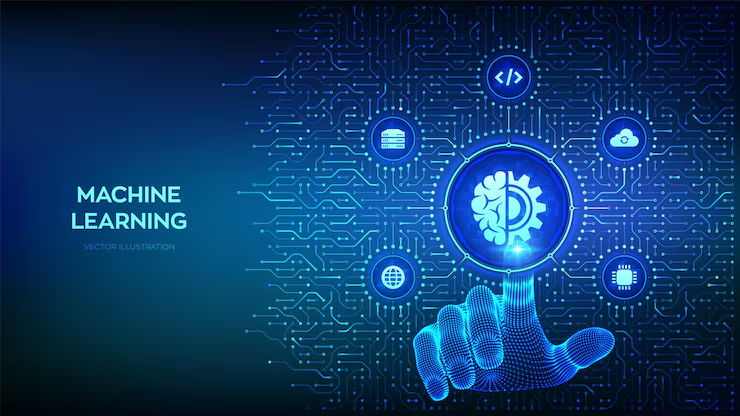Day 1. Introduction to Machine Learning
- What is Machine Learning?
- Traditional Programming vs. Machine Learning
- Types of Machine Learning
- Supervised Learning
- Unsupervised Learning
- Reinforcement Learning
Day 2. Data_Collection_and_Cleaning
- Introduction to Data Collection
- Data Collection - Sources & Methods
- Data Collection - Challenges
- Introduction to Data Cleaning
- Handling Missing Values
- Dealing with Duplicate Data
- Correcting Inconsistent Data
- Outlier Detection & Treatment
- Data Type Conversion & Formatting
- Data Validation & Verification
Day 3. Exploratory_Data_Analysis(EDA)
- What is EDA?
- Importance of EDA
- EDA Techniques
- Introduction to Descriptive Statistics
- Common Metrics in Descriptive Statistics
- Measures of Central Tendency
- Measures of Dispersion
- Example of Descriptive Statistics in Python
- Common Visualization Techniques
- Correlation
- Introduction to Outlier Detection
- Common Methods for Outlier Detection
Day 4. Feature_Engineering
- What is Feature Engineering?
- Importance of Feature Engineering
- Types of Features
- Techniques for Feature Engineering
Day 5. Model_Selection_and_Training
- Introduction
- Model Selection
- Model Training
Day 6. Model_Evaluation
- Introduction to Model Evaluation & Tuning
- Evaluation Metrics for Classification
- Evaluation Metrics for Regression
Day 7. Model_Hyperparameter_Tuning
- What are Hyperparameters?
- Why is Hyperparameter Tuning Crucial?
- Hyperparameter Tuning Methods Overview
- Grid Search: Exhaustive Hyperparameter Search
- Randomized Search: Efficient Hyperparameter Exploration
- Bayesian Optimization: Intelligent Hyperparameter Search
- Grid vs. Randomized vs. Bayesian Search: When to Choose?
- Cross-Validation
- Why Cross-Validation? (Limitations of Single Train/Test Split)
- How K-Fold Cross-Validation Works
- Cross-Validation: Pros & Cons
Day 8. Linear_Regression
- Introduction to Linear Regression
- Assumptions of Linear Regression
- Example : Linear Regression
- Linear Regression Model using sklearn
Day 9. Polynomial_Regression
- Introduction to Non-Linear Relationships
- What is Polynomial Regression?
- Polynomial Regression Equation
- Example: Quadratic Polynomial Regression
- Quadratic Polynomial Regression Model Using sklearn
- Why Use Polynomial Regression?
- Limitations of Polynomial Regression
- When to Use Polynomial Regression
Day 10. Ridge_Lasso_and_ElasticNet_Regularization
- Introduction to Regularization
- Bias-Variance Trade-off
- Types of Regularization
- A Practical Demonstration of L1 (Lasso), L2 (Ridge), and Mixed Regularization
Day 11. Logistic_Regression
- Introduction - What is Logistic Regression?
- Why Not Use Linear Regression for Classification?
- The Sigmoid (Logistic) Function - The Core
- From Probability to Class Prediction
- Cost Function (Loss Function)
- Optimization: Gradient Descent
- Numerical Example
- Advantages & Disadvantages
- Common Applications
Day 12. Decision_Tree
- Introduction
- Key Components of a Decision Tree
- How Decision Trees Learn? (The Algorithm's Core Idea)
- Splitting Criteria - Measuring Impurity
- Building the Tree: The Algorithm Steps
- Numerical Example on Decision Tree
- Overfitting and Pruning in Decision Trees
- Advantages of Decision Trees
- Disadvantages of Decision Trees
- Extensions & Ensemble Methods
- Decision Tree for Classification (Implementation using Iris Dataset)
Day 13. Ensemble_Learning
- What is Ensemble Learning?
- Why Ensemble Learning? The Motivation
- Core Principles of Ensemble Learning
- Types of Ensemble Methods
- Bagging (Bootstrap Aggregating)
- Boosting
- Stacking / Voting / Blending
- Advantages of Ensemble Learning
- Disadvantages & Challenges
- Choosing the Right Ensemble Method
Day 14. Random_Forest
- What is Random Forest?
- How It Works: The Core Process
- Out-of-Bag (OOB) Evaluation
- Strengths of Random Forest
- Weaknesses of Random Forest
- Key Hyperparameters
- Applications
- Predicting Customer Churn: A Random Forest Example
Day 15. Support_Vector_Machines(SVM)
- What is a Support Vector Machine (SVM)
- Linear SVM
- Mathematical Formulation (Hard and Soft Margin)
- Non-Linear SVM
- Common Kernel Functions
- Hyperparameter Tuning
- SVM for Regression (SVR)
- Advantages of SVMs
- Disadvantages of SVMs
- SVM implementation
Day 16. K-Nearest_Neighbors(KNN)
- Introduction to K-Nearest Neighbors (KNN)
- How KNN Works: The Core Algorithm
- Key Concept
- Advantages of KNN
- Disadvantages of KNN
- The Curse of Dimensionality
- Feature Scaling: Why it's Crucial for KNN
- Numerical Example
- KNN for Regression
- Hyperparameter Tuning: Finding the Optimal K
- Weighted KNN (An Extension)
- Use Cases of KNN
- K-Nearest Neighbors (KNN) Implementation
Day 17. Naive_Bayes
- What is Naive Bayes?
- Why "Naive"? The Core Assumption
- Naive Bayes Algorithm
- Types of Naive Bayes Classifiers
- Naive Bayes Algorithm Advantages
- Naive Bayes Algorithm Disadvantages
- Numerical Example: Spam Detection
Day 18. Gradiant_Boosting
- Introduction to Ensemble Learning
- Understanding Gradient Boosting Machines (GBM)
- Advantages of Gradient Boosting
- XGBoost (eXtreme Gradient Boosting)
- LightGBM (Light Gradient Boosting Machine)
- XGBoost vs. LightGBM: A Comparison
Day 19. K_Means_Clustering
- What is Clustering?
- Introduction to K-Means Clustering
- Key Concepts in K-Means
- The K-Means Algorithm
- Choosing the Right 'K'
- Numerical Example
- Advantages of K-Means
- Limitations of K-Means
- Real-World Applications
- The K-Means Clustering Algorithm using Scikit-Learn
Day 20. DBSCAN
- What is Clustering?
- DBSCAN Core Concepts
- The DBSCAN Algorithm
- Numerical Example
- Advantages of DBSCAN
- Disadvantages of DBSCAN
- The DBSCAN Clustering Algorithm using Scikit-Learn
Day 21. Hierarchical_Clustering
- What is Clustering?
- Introduction to Hierarchical Clustering
- Types of Hierarchical Clustering
- Agglomerative Hierarchical Clustering Algorithm
- Key Concept: Linkage Criteria
- The Dendrogram
- Divisive Hierarchical Clustering Algorithm
- Advantages of Hierarchical Clustering
- Disadvantages of Hierarchical Clustering
- Applications of Hierarchical Clustering
- Numerical Example
- Hierarchical Clustering Implementation
Day 22. Principal_Component_Analysis (PCA)
- What is PCA?
- Why PCA?
- Core Concepts of PCA
- How PCA Algorithm works
- Numerical Example
- Advantages of PCA
- Limitations of PCA
- Applications of PCA
- Implementation of PCA using Scikit Learn
Day 23. Perceptrons & Multi-Layer Perceptrons (MLPs)
- Introduction to Neural Networks
- The Perceptron: The First Artificial Neuron
- Multi-Layer Perceptrons (MLPs)
- Perceptrons vs. Multi-Layer Perceptrons (MLPs)
Day 24. Activation_Functions
- What are Activation Functions?
- Why Do We Need Them? (The Non-Linearity Imperative)
- Sigmoid Function(Logistic Function)
- Tanh Activation Function
- ReLU( Rectified Linear Units) Activation Function
- Leaky ReLU Activation Function
- Exponential Linear Units(ELU) Activation Function
- Softmax Activation Function
Day 25. Forward_and_Backward_Propagation
- Forward Propagation
- Feed Forward Neural Network Structure
- Backward propagation
- Flow of Backward Pass
Day 26. Optimizers
- Introduction to Optimizers
- Gradient Descent (GD)
- Types of Gradient Descent
- Advantages of Gradient Descent
- Disadvantages and Challenges in Gradient Descent
- Momentum
- Nesterov Accelerated Gradient (NAG)
- Adaptive Learning Rate Methods
- Adagrad (Adaptive Gradient Algorithm)
- RMSprop (Root Mean Square Propagation)
- Adam (Adaptive Moment Estimation)
- Adadelta
- Learning Rate Schedules and Advanced Techniques
- Choosing an Optimizer
Day 27. Convolutional_Neural_Networks(CNNs)
- What are Convolutional Neural Networks (CNNs)?
- The Challenge of Traditional MLPs
- Why CNNs Excel for Image Data
- Core Building Blocks of a CNN
- CNN Architecture
- Training a CNN - The Learning Process
- Real-World Examples & Applications
- Advantages of CNNs
- Limitations of CNNs
- Advanced Concepts & Future Trends
Day 28. Recurrent_Neural_Networks(RNNs)
- Introduction
- Key Features of RNNs
- RNN Architecture
- How RNNs "Remember" - The Hidden State(Example)
- Applications of RNNs
- Challenges with Basic RNNs
- Overcoming Challenges - Gated RNNs
- LSTM vs. GRU
- Implementation of RNN Using Pytorch






